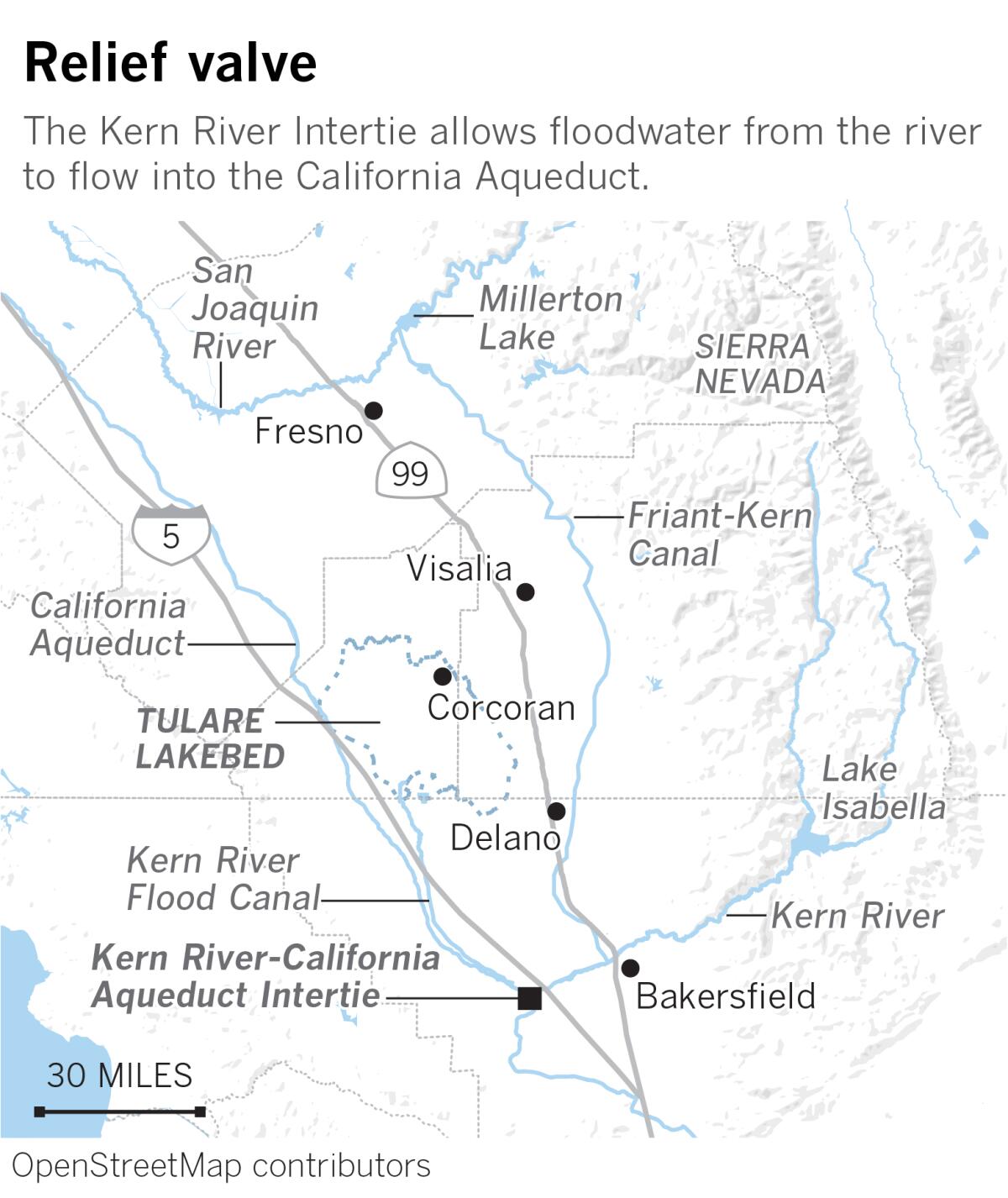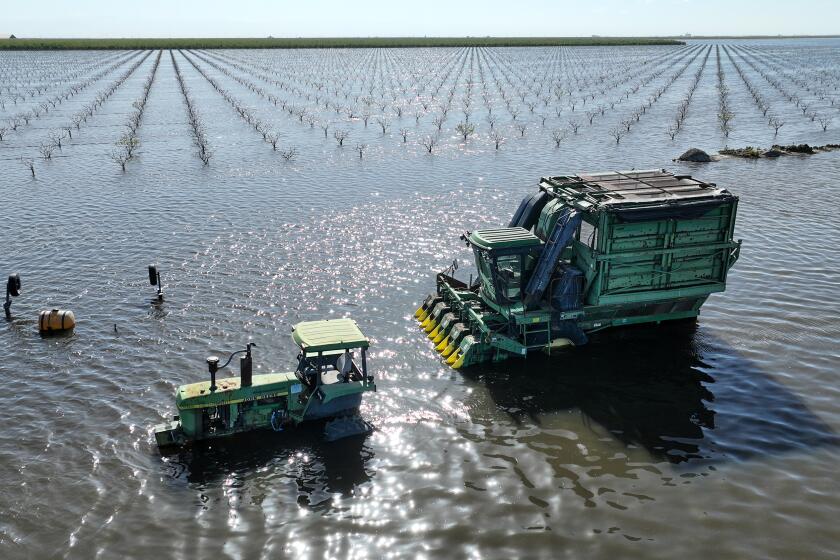California triggers rarely used relief valve on Kern River, diverting flows to state aqueduct

- Share via
The Kern River is swollen with so much runoff from the epic Sierra Nevada snowpack that officials have opened a rarely used relief valve, diverting floodwaters into the California Aqueduct to be used as drinking water in Southern California.
Opening this flow relief valve, known as the Kern River Intertie, is intended to prevent floodwaters from reaching Tulare Lake, a typically dry lake bed that in recent weeks has experienced a dramatic resurgence, replenished by powerful winter storms and, now, heavy spring runoff.
In the early 20th century, the lake was drained as farmers diverted flows from the rivers that fed it and transformed the lake bed into a center of industrial agriculture. The phantom lake’s sudden reemergence has swallowed thousands of acres of valuable farmland and is encroaching on low-lying towns such as Corcoran.
It marks the first time since 2006 that the intertie, which connects the Kern to the aqueduct west of Bakersfield, has been activated. The gates of the 320-foot-long channel were opened Saturday to begin taking in floodwater.
Karla Nemeth, director of the state Department of Water Resources, stressed that the move is not a response to an “immediate public safety issue” to residents. The goal, she said, is to “do what we can to limit the amount of water that ends up in the lake bed.”
“The less water up against the Corcoran levee, the better,” she said.

The intertie functions like a gated alley connecting two much larger streets. On one side lies a stretch of the Kern River called the Buena Vista Channel; on the other is the California Aqueduct, a simple name for a complex system of tunnels and pipelines that transports water from Northern California and the Sierra to the state’s arid central and southern expanses.
To open the connection, operators lower the aqueduct’s water level below that of the intertie basin. When the gates separating the two are opened, gravity moves the Kern River water into the aqueduct. The flow was expected to start at a rate of 500 cubic feet per second and will increase to 1,000 cubic feet per second later this month.
Over two months, state officials said, about 75,000 acre-feet of Kern River water will pass into the aqueduct, enough to supply approximately 225,000 homes for a year.
The U.S. Army Corps of Engineers built the connection to the aqueduct in 1977 to reduce flood risks for communities around the Tulare Lake Basin by redirecting flows when the Kern River runs fast and high. Dam managers have been releasing unusually high flows from Lake Isabella in the southern Sierra, where the Kern is dammed, to create room for the historic snowmelt. That, in turn, has fueled the Kern, and water managers said they determined that without intervention, the flows would course through the river channel into Tulare Lake.
“That’s why the intertie was designed, authorized and built, was to control just this kind of a flood situation,” said Mark Mulkay, the Kern River watermaster who asked the state to activate the facility.
The only thing preventing floodwaters from inundating the city of Corcoran is an aging, 14-mile-long wall of dirt. Can it hold?
Gov. Gavin Newsom signed an executive order this week facilitating the water diversions as part of emergency flood response efforts. Local irrigation districts are already diverting as much water as they can handle to supply crops and fill groundwater recharge facilities.
“Everything is full. All of our irrigation demands are being met,” Mulkay said. “We’ve offered water to everybody, and we think we’ve done a pretty good job of making sure that all of the recharge ponds are full. So this is, in fact, water over and above what can be managed here in Kern County without causing flood damages.”
The only place left to send the water safely is via the aqueduct to the cities of Southern California, where the Metropolitan Water District will mix it with flows from Northern California, treat it and send it to taps.
Snowpack in the southern Sierra stands at more than 400% of average for this time of year, meaning unusually high runoffs could continue for months. But Nemeth said the peak snowmelt for the Kern watershed will play out “within the next week or two.”
In addition to dealing with the snowpack, local water officials have been struggling to develop plans for combating chronic overpumping of groundwater in the San Joaquin Valley, which has left some residents with dry wells and caused the land to sink several feet in portions of the Tulare Lake Basin.
State regulators have declared local groundwater management plans inadequate in six areas of the San Joaquin Valley, including the Kern and Tulare Lake subbasins.
With more water flowing in the Kern River than the area can handle, the situation underscores the region’s unrealized potential for aquifer recharge, Nemeth said. Local agencies need to get infrastructure in place that enables them to preserve more of the bounty the next time California gets a wet year, she said.
“When we look to the future, we want to be using the intertie less and less frequently, so that local communities and the groundwater sustainability agencies can capture those flood flows and recharge their groundwater basins,” Nemeth said. “That is the future.”










